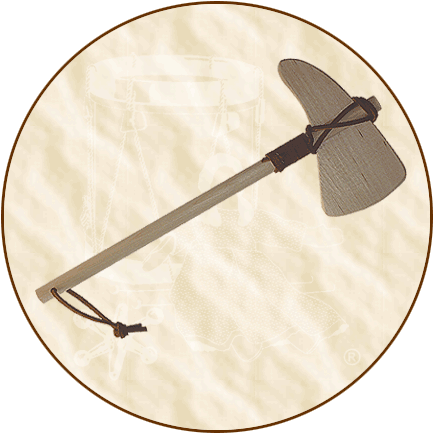.
Continued from product description on
Native American's Page Two...
Historical
Background: The tomahawk has a long history in North America.
American Indians used these light axes as both a tool and a weapon.
Later, English sailors adopted the tomahawk name for the boarding
ax used to disable and seize enemy ships. This boarding ax was
also used in the earliest days of the United States Navy. On
August 3, 1804, Captain Steven Decatur reported the seizure of
a Tripolitan gunboat and stated: "Pistol, saber and tomahawk
were made good use of by our brave Tars."
Native American tomahawks were originally a wooden stick with
a stone head. The stone head could have one or two sharpened
edges. Sometimes a piece of deer antler or large animal jaw bone
was used. The head was fastened to the wooden handle by either:
sticking the head through a hole in the wood; splitting one end
of the handle and lashing the head into the crevasse; or, tying
leather thongs around the head and handle.
Early American settlers found this light, hatchet-like implement
to be a versatile and superior tool when made with a steel head.
European-made tomahawks soon became a highly prized trade item
by Native Americans and continued to be until the late 1800s.
The tomahawk also became a piece of standard equipment used by
European frontiersmen who traded, trapped, and explored in North
America.
While Native Americans typically used tomahawks as a hatchet-like
tool or in hand-to-hand combat, tomahawks could also be used
as missiles. A well-balanced tomahawk could be thrown with amazing
accuracy as well as deadly force. Many Indian tribes held tomahawk-throwing
contests because it was considered an important skill to have.
This was certainly the case when it came to saving one's own
scalp. Speaking of which, knives were generally used to take
an enemy's scalp. Contrary to popular belief, tomahawks were
only used for scalping when a warrior had to do a "rushed
job."
Many people think of the tomahawk as only a weapon -- either
a lightweight hatchet used by Indians long ago or a cruise missile
used by today's U.S. Navy. The tomahawk was, however, also a
tool, a ceremonial object, a decorative item, and a symbol of
friendship.
One type of tomahawk was used to seal peace treaties or make
tribal alliances. This tomahawk had a pipe bowl at the other
end of the haft. A hollow stem was affixed to the end with the
pipe bowl. Pipe tomahawks were often smoked at tribal pow wows
and council meetings, presented as gifts to important chiefs,
given to seal a friendship, and used to commemorate treaties.
Ceremonial tomahawks were decorated in as an elaborate manner
as possible. They could have painted designs, engraved markings,
metal heads, and wooden handles with inlaid silver or pewter
-- and even have eagle feathers tied to them.
In fact, the majority of Indian tomahawks were personalized
in some way by their owners. The methods of adornment varied
greatly. How they were decorated depended primarily on what materials
were available as well as the styles of the time and customs
of the region. According to Native-American-Art.com: "Hafts
were polished smooth, carved, scalloped, inlaid, branded with
hot files, tacked, wrapped with copper or brass wire, covered
with rawhide, leather or cloth, stained, painted and hung with
every type of ornament imaginable."
The tomahawk perseveres today as an ubiquitous symbol and
reminder of Native Americans, along with the war bonnet, totem
pole, and teepee. And young American boys continue to "whoop
it up" playing with their toy tomahawks just as they did
many, many moons ago.
Fun
Fact: The name "tomahawk" is derived from either
the Algonquian word "tamahak" or "tamahakan."
Fun
Fact: American Indian tribes made peace with their enemies
using the tomahawk. The ceremony included burying a tomahawk
in the ground to symbolize there was no longer a need for it
as a weapon. Many believe this is why we say "bury the hatchet."
Fun
Fact: A tomahawk-throwing target was a slice of tree trunk
approximately 12-18 inches in diameter and at least 6 inches
thick. It was supported by some means at least a handle length
off the ground so it wouldn't hurt the blade in case of a missed
throw.













